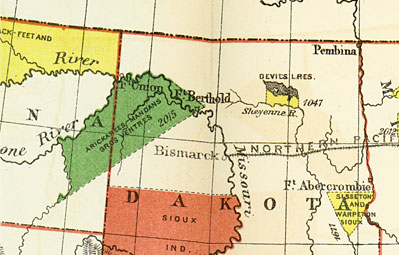 Government
Indian policy has long been likened to a swinging pendulum, swinging
between one extreme or another. At the time of the Lewis and Clark
expedition, the prevailing policy was a loosely-bound set of rules
collectively known as the Indian Trade and Intercourse Acts. It was
replaced in the 1820's and 1830's with Removal, a policy that resulted
in the infamous “Trail of Tears” dealing with the Five
Civilized Tribes (Cherokee, Chocktaw, Chickasaw, Creek, and Seminole)
in the American Southeast. These tribes, along with others in subsequent
years, were forcibly removed from their homelands to the southern
Great Plains of Oklahoma, then called “Indian Territory”.
Upwards of a third of those removed died along the way as a result
of disease, lack of promised food and supplies, and other government
support.
Government
Indian policy has long been likened to a swinging pendulum, swinging
between one extreme or another. At the time of the Lewis and Clark
expedition, the prevailing policy was a loosely-bound set of rules
collectively known as the Indian Trade and Intercourse Acts. It was
replaced in the 1820's and 1830's with Removal, a policy that resulted
in the infamous “Trail of Tears” dealing with the Five
Civilized Tribes (Cherokee, Chocktaw, Chickasaw, Creek, and Seminole)
in the American Southeast. These tribes, along with others in subsequent
years, were forcibly removed from their homelands to the southern
Great Plains of Oklahoma, then called “Indian Territory”.
Upwards of a third of those removed died along the way as a result
of disease, lack of promised food and supplies, and other government
support.
Following Removal, there was something of a transition period (1851-1887)
that began with the Ft. Laramie Treaty of 1851. The idea among reformers
was to avoid the holocaust visited upon the Removal victims by making
treaties with the next group of Native Peoples with whom the federal
government would come into contact: the plains peoples. Unfortunately,
this policy also failed as one conflict after another arose resulting
in considerable US Army losses. This culminated in the Battle of the
Little Big Horn, a fight that was a direct result of the US government’s
broken promise to keep west river South Dakota in general and the
Black Hills in particular safely in the hands of the Lakota Sioux.
The Dawes Act era (1887-1935) followed the failed transition period.
Its basic premise was to break reservations into individual land allotments
as a means of “assimilating” Native Peoples into white,
American Society. By using individual land allotments as a means of
breaking tribal culture, the federal government sought to end wardship
status once and for all. In the end, it destroyed a culture that had
existed for generations and in its place established broken promises,
forced conversion to Christianity, farming, and the education of the
young at boarding schools, sometimes at great distances from the reservation(s).
The Dawes Act is to this day rightly considered the most destructive
policy dealing with Native Peoples ever conceived.
In an effort to rectify some of the damage done, the Indian Reorganization
Act, also known as the Wheeler-Howard Act, became policy under Franklin
Roosevelt and his BIA director, John Collier. Although certainly an
improvement over previous policies, it still was paternalistic in
its implementation and sometimes heavy-handed. Nonetheless, a number
of tribes voted to be part of the new policy. One of those who did
not was the Turtle Mountain band of Chippewa (Ojibwa); after losing
some ten million acres to the federal government, they were understandably
cautious about any new programs. The IRA (or Indian New Deal) lasted
until disassembled by conservative Republicans in the late 1940's
and early 1950's.
The Republican plan was to establish a policy that would eliminate
tribal status all together in a plan referred to as “Termination”.
The idea was to cut the ties between the federal government and tribes
over the course of time. Part of this involved the relocation of certain
tribal members to urban areas where, it was hoped, assimilation would
take place. The policy was an abject failure as tribes who had their
tribal status terminated became poverty stricken. This would lead
to yet another change in policy, this time under Democratic President
Lyndon Johnson and was part of the Great Society.
Finally, in 1973, President Richard Nixon implemented what became
known as “Self Determination”, a policy meant to allow
tribes autonomy while at the same time still benefitting from government
treaty obligations. Implicit in this was protection from state government
interference as well, something increasingly important as a result
to the rise of gaming on reservations.
Address:
612 East Boulevard Ave.
Bismarck, North Dakota 58505
Get Directions
Hours:
State Museum and Store: 8 a.m. - 5 p.m. M-F; Sat. & Sun. 10 a.m. - 5 p.m.
We are closed New Year's Day, Easter, Thanksgiving Day, and Christmas Day. We are closed at noon Christmas Eve if it falls on Mon.-Thurs. and are closed all day if it falls on Fri.-Sun.
State Archives: 8 a.m. - 4:30 p.m. M-F, except state holidays; 2nd Sat. of each month, 10 a.m. - 4:30 p.m. Appointments are recommended. To schedule an appointment, please contact us at 701.328.2091 or archives@nd.gov.
State Historical Society offices: 8 a.m. - 5 p.m. M-F, except state holidays.
Contact Us:
phone: 701.328.2666
email: history@nd.gov
Social Media:
See all social media accounts